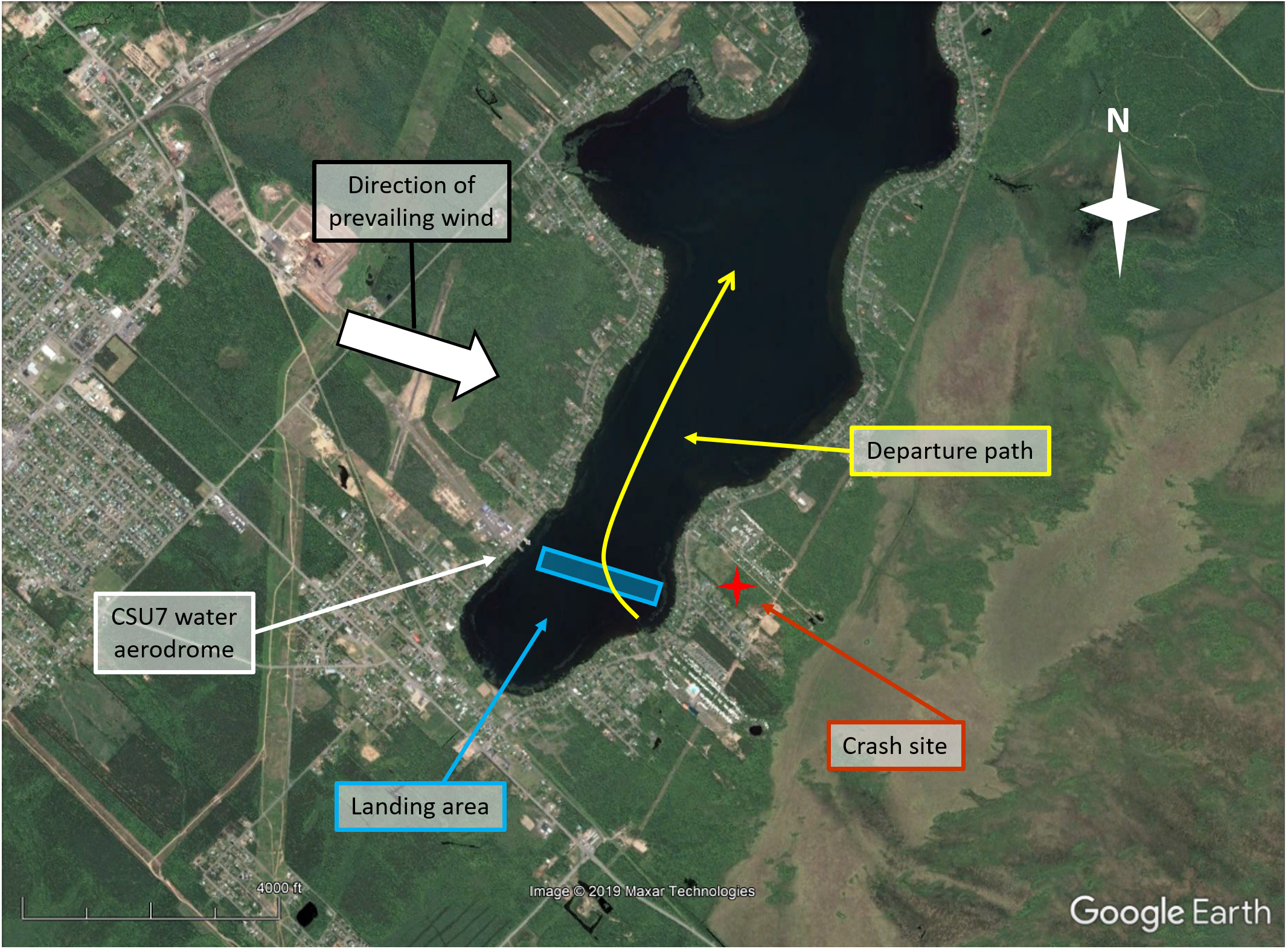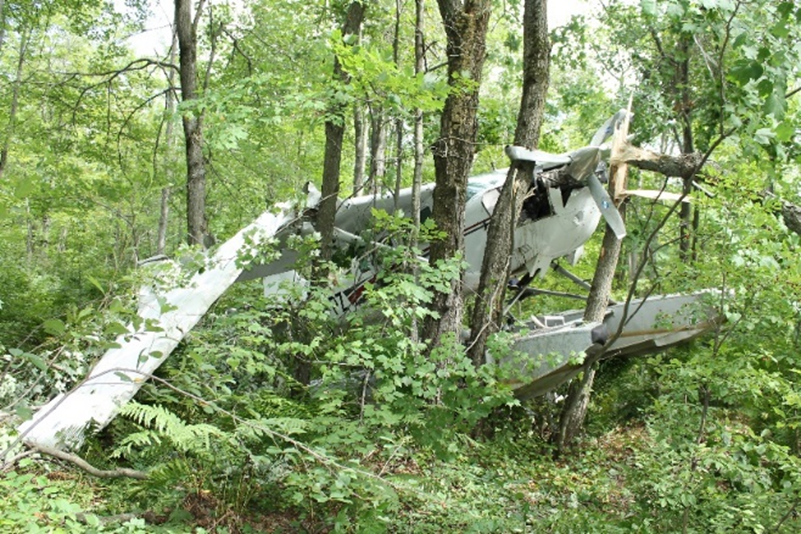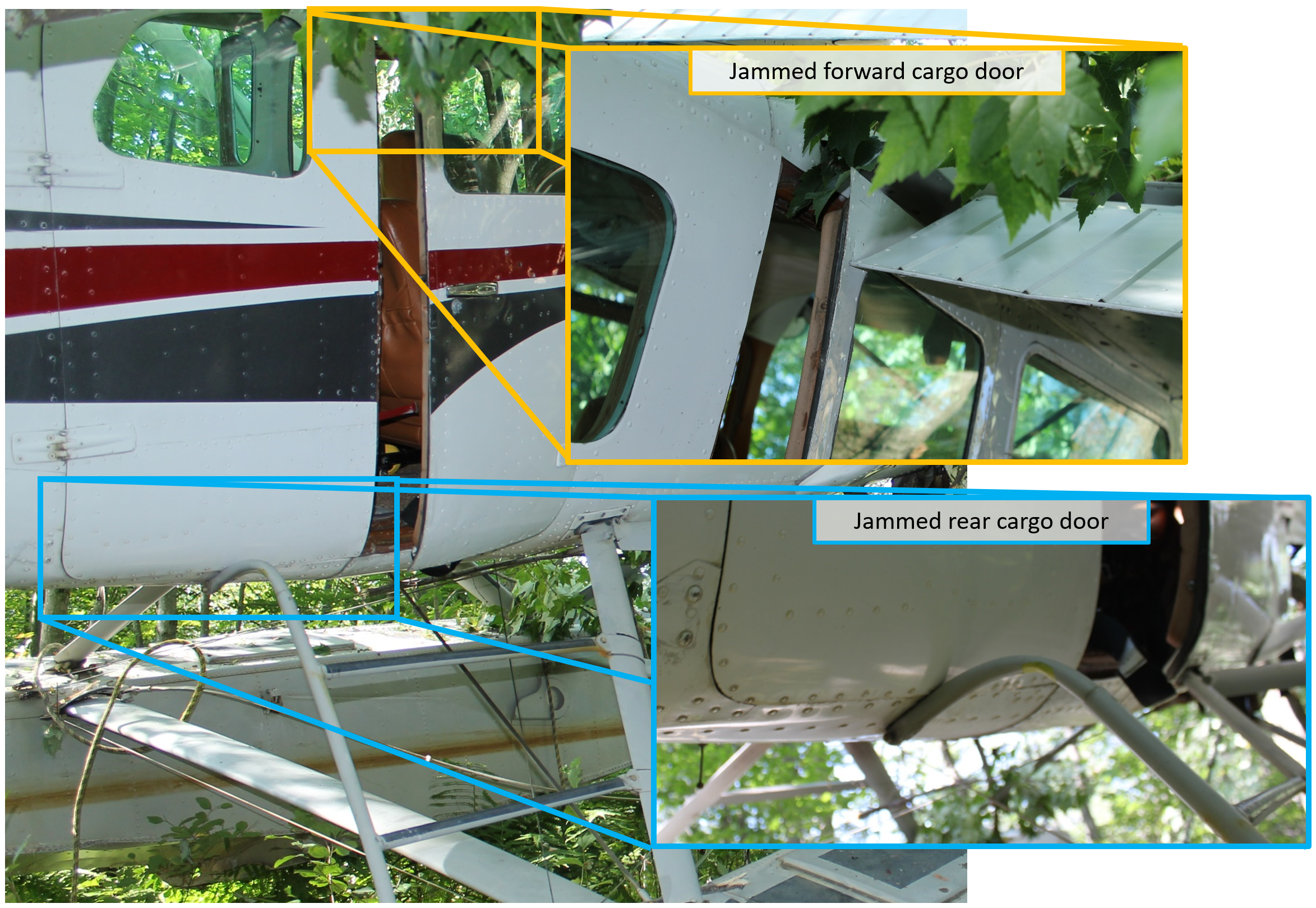Bel Air Laurentien Aviation Inc.
Cessna U206G on floats, C-GPPZ
Lac-à-la-Tortue, Quebec
22 August 2019
The Transportation Safety Board of Canada (TSB) investigated this occurrence for the purpose of advancing transportation safety. It is not the function of the Board to assign fault or determine civil or criminal liability. This report is not created for use in the context of legal, disciplinary or other proceedings. See Ownership and use of content. Masculine pronouns and position titles may be used to signify all genders to comply with the Canadian Transportation Accident Investigation and Safety Board Act (S.C. 1989, c. 3).
Background
At approximately 0830Footnote 1 on 22 August 2019, the pilot began his day with a pre-flight check of the float-equipped Cessna U206G aircraft (registration C-GPPZ, serial number U206-06568), operated by Bel-Air Laurentien Aviation Inc. (Bel-Air). The pilot was scheduled to conduct sightseeing flights under visual flight rules (VFR) from and to the Lac-à-la-Tortue Water Aerodrome (CSU7), Quebec.
That morning, the floatplane was fuelled, with each of its 2 tanks filled to approximately 20 gallons.Footnote 2 The pilot then conducted 3 sightseeing flights of approximately 20 minutes each. After these 3 flights, the pilot checked the remaining fuel level using a home-made dipstick. He noted 10 gallons in the left tank and 15 gallons in the right tank. Knowing that the floatplane used approximately 5 gallons per sightseeing flight, the amount of fuel noted by the pilot was enough for the 3 remaining sightseeing flights to be conducted in the afternoon, while keeping the mandatory minimum reserve required for 30 minutes of flight.Footnote 3
The pilot then conducted his first 2 afternoon flights. He took off in a northeasterly direction, following a departure path that provided a greater distance of the lake’s surface than a takeoff fully into the wind (Figure 1). After flying his usual flight path, he returned and landed in a northwesterly direction, into the prevailing wind.
History of the flight
At approximately 1450, the pilot took off for his 3rd sightseeing flight that afternoon, using the same departure path as the previous 2 flights. The pilot and 5 passengers were on board. As the pilot was returning to CSU7, at approximately 3 nautical miles (NM) northwest of the water aerodrome, another aircraft was also heading to the water aerodrome. The occurrence pilot communicated to the other pilot that he would let him land first and that he would extend his own flight in order to maintain safe separation.
The flaps were set to 20° in preparation for landing, and at approximately 1507, as the pilot was turning northwest for the final approach, the engine stopped. The pilot steered the floatplane toward a wooded area to avoid a campground ahead. At the same time, he carried out the emergency procedure for an engine failure. He set the fuel selector to the left tank and turned on the auxiliary electric fuel pump. The engine restarted 5 seconds after it had stopped.
As per the emergency procedure, the pilot then turned off the auxiliary electric fuel pump. Six seconds later, the engine stopped again. As the floatplane was grazing the treetops, the pilot focused on flying the aircraft in order to avoid stalling in the trees. The pilot attempted to restart the engine by turning the auxiliary electric fuel pump back on, but was unsuccessful, and the floatplane struck the trees immediately afterward, 6 seconds after the 2nd engine failure. The floatplane came to a stop in the woods approximately 1000 feet from the lake. The pilot received minor injuries to the head, 1 passenger received minor injuries, and the other 4 passengers were not injured.
The 406 MHz emergency locator transmitter activated on impact, and the 1st signal was received by the Joint Rescue Coordination Centre in Trenton, Ontario, at 1511.
Once he saw that all of the passengers appeared to be unharmed, the pilot opened the main door, on the aircraft’s forward left side, and broadcast a message on the radio to report an engine failure. A passenger attempted to open the rear right cabin double cargo door, but the door was jammed because the flaps were down. The pilot secured the aircraft while the passengers exited using the main door. The pilot then exited the aircraft. A group of campers rushed to the site to provide assistance.
Weather information
According to the weather station in Shawinigan, Quebec, approximately 5 NM southwest of CSU7, at the time of the accident, moderate surface winds were from 300° true at 12 km/h, and weather conditions were favourable for the VFR flight. Consequently, weather conditions were not considered a contributing factor in this accident.
Pilot information
The pilot held a commercial pilot licence - aeroplane, with a seaplane rating, and a valid Category 1 medical certificate. He was trained in accordance with the operator’s approved training program. According to information gathered during the investigation, the pilot had accumulated approximately 760 hours of total flight time, including 515 hours on Cessna 206.
The investigation did not find any indicators that the pilot’s performance was degraded by fatigue or physiological factors.
Aircraft information
The occurrence floatplane was built in 1982 and was certified, equipped and maintained in accordance with existing regulations and approved procedures. The journey log indicated that, at 20 August 2019, the floatplane had accumulated 10 609.9 flight hours since new.
The floatplane had no known deficiencies, and it was being operated within its weight and centre-of-gravity limits. The aircraft did not have a flight recorder on board, nor was one required by regulation.
Accident site and wreckage examination
The area surrounding the wreckage, approximately 1000 feet southeast of the lake, was a woodland with large, deciduous trees. The first signs of an impact with trees could be found approximately 250 feet southeast of the wreckage (Figure 2).
The engine had shifted forward and its mount was stripped from the engine firewall. A brief examination of the engine by investigators found no signs of a defect that could have caused the sudden engine failure. The propeller showed signs that are consistent with it still turning on impact. The mechanical and electric fuel pumps were sent to the TSB Engineering Laboratory in Ottawa, Ontario, for further examination.
The forward cargo door was partially open and jammed because the flaps were down. This issue, specific to the Cessna 206, was identified and analyzed during TSB investigation A18W0129 and resulted in Aviation Safety Advisory A18W0129‑D1‑A1.Footnote 4 The rear cargo door of the occurrence aircraft was closed and the locking lever was in the stowed position. Investigators attempted to open the rear cargo door, but the top of the ladderFootnote 5 was bent from the impact and was preventing the rear cargo door from being opened (Figure 3).
The cabin was not damaged. The shoulder harnesses for the front seats were found stored in their respective compartments. The fuel tank selector was in the “OFF” position, which was consistent with the pilot having secured the aircraft. A portable GPS (global positioning system) device was found on the accident site, but it did not have any data on the flight path.
The wings were damaged, but the 2 fuel tanks were intact, and there were no signs of a spill. The tanks and fuel lines were drained to check the amount of fuel remaining: the right tank contained 0.33 gallons, the left tank contained 3.58 gallons, and the fuel lines contained 0.29 gallons.
Fuel management
The fuel supply system includes 2 pumps: an engine-driven mechanical pump and an auxiliary electric pump, activated by a switch in the cockpit. An examination of the 2 pumps revealed no deficiencies; they were functioning properly.
The floatplane had 2 fuel tanks, with a total capacity of 92 gallons. According to the manufacturer, the quantity of unusable fuel per tank is 2 gallons.Footnote 6 The pilot uses 2 fuel gauges, one for each tank, to determine the amount of fuel left. The fuel tank selector valve has 3 positions (LEFT, OFF, RIGHT), which enables the pilot to select the left or the right tank to fuel the engine.
The fuel gauges were serviceable for the flight and met the aircraft certification basis criteria. However, it seems that the pilot did not rely on the information provided by the fuel gauges, because it was not always accurate. The TSB has already investigated the well known lack of precision of fuel gauges in aircraft with similar gauges,Footnote 7 especially when the fuel quantity is below the ¼ mark. As a result, operators of this type of aircraft have turned to making their own dipsticks to measure the quantity of fuel by inserting the stick all the way to the bottom of the tank through the filler cap.
These dipsticks are usually graduated by filling an empty tank in 5-gallon increments, and marking the level of fuel in the tank on the dipstick each time. Some operators prefer that the first 5-gallon increment indicate only usable fuel, while others prefer that it indicate the actual quantity of fuel in the tank. To ensure that the fuel level markings are as accurate as possible, the floatplane must be empty and must be in its normal position on still waterFootnote 8 while graduating the stick. Once the dipstick is graduated, some operators will document the markings, for instance by reproducing them on a page in the aircraft’s journey log.
Although using graduated dipsticks is common practice, the aircraft manufacturer does not provide any standards or recommendations on the subject. The investigation was unable to determine the origin of the occurence floatplane’s dipstick, or its marking procedure.
The dipstick used by the pilot was doubled, consisting of 2 sticks glued together at one end (Figure 4). The 1st stick, which was dark brown, had several notches at regular intervals, and 3 black pen markings indicating 10, 15, and 20 gallons. These markings were offset from the notches. The 2nd stick, which was a lighter colour, had blue pen lines indicating 5, 10, 15, and 20 gallons and was labelled ”BON” [good] at the unmarked end (Figure 4). These markings were only visible by spreading the 2 sticks apart. The blue pen marks on the 2nd stick closely matched the notches on the 1st stick. A comparison of the various markings revealed that the black pen marks appeared to indicate quantities approximately 2.5 gallons greater than the quantities indicated by the other markings.
There was no operating instruction regarding the use of a home-made dipstick, and the operator’s training program did not cover this subject. The pilot of the occurrence aircraft was not trained to use the dipstick for this aircraft. He was relying on the black markings on the 1st stick without realizing that the 2nd stick had another set of markings.
The TSB examined other dipsticks, including one used by another Cessna U206G operator whose aircraft was equipped with the same type of floats and fuel tanks. The black markings on the stick used by the occurrence pilot appeared to indicate quantities approximately 3.5 gallons greater than the quantities indicated by the other operator’s stick.
Based on the blue markings each of the tanks would have contained approximately 17.5 gallons of fuel rather than 20 gallons after fuelling in the morning. When the fuel level was checked with the black markings after the 3rd flight on the morning of the occurrence, there was supposedly 10 gallons remaining in the left tank and 15 gallons in the right tank. However, according to the blue markings, there was, in reality, 7.5 gallons remaining in the left tank and 12.5 gallons in the right tank.
Given that the 1st and 3rd flights in the afternoon were conducted using fuel from the right tank, there should have been approximately 2.5 gallons remaining in the right tank by the end of the 3rd flight. According to information gathered, the taxiing time to the takeoff area was longer than usual and the take-off paths were extended for the 3 afternoon flights. Furthermore, the last flight was extended on the return. These 3 elements resulted in more fuel being used than what was expected. The amount of fuel collected by the TSB at the accident site was 0.33 gallons on the right, which was below the minimum usable fuel level. That small amount of fuel led to the engine failure.
Safety belts
The pilot and the front seat passenger were not wearing the available shoulder harnesses. The pilot received minor injuries to the head.
Not wearing a shoulder harness is common practice on floatplanes, because it is often reported that the shoulder harness impedes the pilot’s movements. Also, it is often incorrectly reported that the regulationsFootnote 9 do not specifically require its use. The TSB has previously investigated this inaccurate interpretation of the regulations regarding the use of shoulder harnessesFootnote 10 and recently issued recommendation A19-01, in which it recommended that:
the Department of Transport amend the Canadian Aviation Regulations to remove any ambiguity associated with the definition of “safety belt.”
TSB Recommendation A19-01
Safety action taken
Bel-Air took the following action after the occurrence:
- The company checked the dipstick of its other Cessna 206. The fuel level indication was accurate for both tanks.
- A new procedure was introduced, making it mandatory to check the fuel level with a dipstick every time the aircraft is fuelled and after every 2 sightseeing flights.
Safety messages
Operators and pilots who use a home-made dipstick as a tool for measuring fuel should ensure that the markings are calibrated and documented based on parameters specific to their aircraft, including the quantity of unusable fuel in the tanks and the type of landing gear on the aircraft when calibrating.
It is important to wear shoulder harnesses when the aircraft is equipped with them. Their use reduces the risk of injury or death in the event of an accident.
This report concludes the Transportation Safety Board of Canada’s investigation into this occurrence. The Board authorized the release of this report on . It was officially released on .



